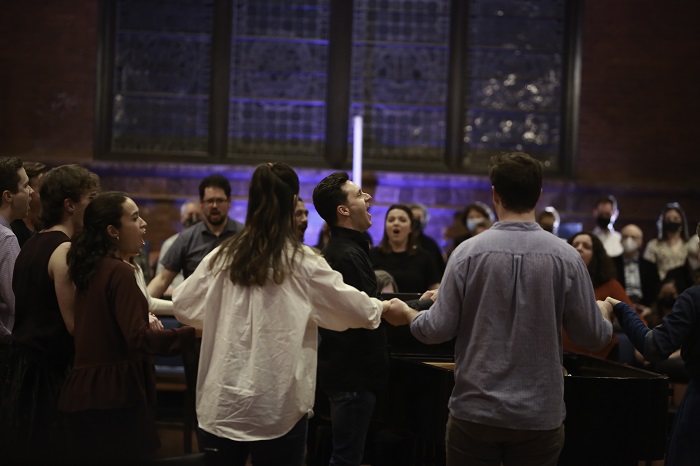The Thirteen sings of love and death in unaccompanied tour de force

Matthew Robertson (center) conducted The Thirteen Saturday night at St. Paul’s, K Street.
The Thirteen stood true to their name Saturday night, in the resonant sanctuary of St. Paul’s, K Street. Twelve singers and their conductor, Matthew Robertson, confronted a daunting program of unaccompanied music in a space made expressly for it. With one singer, presumably with perfect pitch, providing the starting note for each piece, there was no need for any instrument to be played, not even a pitch pipe.
For most of the concert, the choir was arranged in mixed formation, in a half-circle on the altar steps. As a result, the voices blended impeccably, from the potent unison start of the opening work, D.C. native George Walker’s O Praise the Lord, a setting of Psalm 117. The ideally tuned open fifths that concluded sections of the piece, perfectly locked into place, rang out with exceptional clarity.
The ensemble showed remarkable range in Anton Bruckner’s Three Graduals. From gravelly bass depths up to triumphant soprano heights, the singers negotiated the surprise harmonic turns of Locus iste with clean intonation. The full chords of Os justi, like a homophonic psalm tone, floated steadily, and a full-throated section in aching suspensions was breath-taking. Robertson’s tempo for Christus factus est was perhaps too fast, but the climax of the piece was thrillingly loud.
Caroline Shaw’s Fly Away I demanded different techniques from the singers. Tenor Blake Beckemeyer sang the piece’s inspiration, an American folk hymn called “When I die, Hallelujah, by and by, I’ll fly away.” Shaw takes fragments of the tune and its words to frame it, in ostinatos that build up larger textures. The sopranos did not always seem completely unified in their attacks, a whisper of uncertainty at the start of their lines that ran through the evening.
After this set of sacred music came Samuel Barber’s Reincarnations, a set of three choral songs. Barber, whose mother had Irish ancestry, turned often to Irish poets, here using Celtic texts by Antoine Ó Raifteirí, known as Raftery, translated into English by James Stephens. The first song, “Mary Hynes,” enthused wildly in its scattershot opening section and then became more serene, especially on the concluding repetitions of the word “airily.”
The middle song, “Anthony,” seethed with lamenting sadness, constructed over a pedal tone on E in the basses. The poem is Raftery’s elegy for Anthony Daly, an activist for farmers in County Galway. Daly was hanged by authorities on flimsy charges of murder, an execution that Raftery may have witnessed. Keening contrapuntal lines grew in strength to a massive climax. The third song, “The Coolin,” dispersed the tension with its imagery of a couple kissing and drinking wine under a coat on a cold hillside.
The first half ended with a world premiere, Ed Rex’s Safe in Their Alabaster Chambers. Set to a poem by Emily Dickinson, about the bodies of the dead lying mute in their graves, the piece opened in a promising way. Rex wrote around a pedal note that moved from voice to voice throughout the first stanza, evoking the permanence of death as other harmonies crushed against it and then fell away.
Rex chose to set all three versions of the poem’s second stanza that Dickinson wrote, producing an intriguing multiplicity of meanings. The music fell into a less original pattern, consisting of held chords in some voices while one part advanced the text. Even with some perilously high soprano writing, the sound was crystalline and expertly tuned on a series of chords sugared with mild dissonance. The ending, on an unresolved chord, hinted at the significance of this triplicate second stanza, as the world above the graveyard went on, unheeding of the loss of any one soul. The piece, however, did not not capitalize on its satisfying start.
The most complicated music came on the second half, starting with two byzantine motets of Brahms. The stronger interpretation came with Warum ist das Licht, in which Brahms set decidedly uncheery texts from Job and Lamentations in ever more contorted counterpoint. Full chords declaiming the word “Warum?” (Why) punctuated the texture, a frustrated questioning of the misery of human existence. Taking its cue from Bach, whose cantata structure Brahms emulated, the piece ended with a lovely chorale on a text and melody by Martin Luther, capping an extraordinary performance.
In a sign of the difficulty of the final piece, Britten’s Sacred and Profane, the singers reverted to standing in their sections. Having various singers read the modern English translations of the Old English texts helped set the mood of these often strange choral songs. Britten’s enigmatic, bitingly dissonant style could be off-putting, and the five-part SSATB texture put further pressure on the soprano section.
After the first four songs, which fell somewhat leadenly, the last four opened up in striking ways. Sara MacKimmie floated the high-flying soprano solo of the fifth song, “Yif ic of luve can,” from the lectern, seemingly untouched while her colleagues clashed in exquisite dissonances symbolizing Christ’s wounds. The six male voices made a magnificent roar in “Ye that pasen by,” and the curious final song, “A Death,” made a disturbing portrait of one’s own passing and burial, with a surprise ending.
The program will be repeated 5 p.m. Sunday at Bradley Hills Presbyterian Church and can also be viewed online. thethirteenchoir.org
